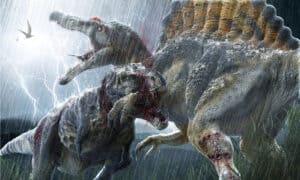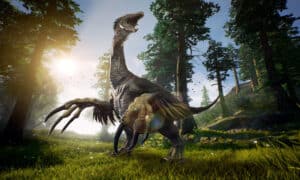A rhino is famous because of the large horn that protrudes from its face, but some dinosaurs that lived millions of years ago also have this feature. Rhinos use their horns to defend territories, take care of the young, dig, and. While it is not known exactly what dinosaurs used their horns for, it is believed they could have used them to show off, defend themselves, and attract a mate. While rhinos are present in the world today, here you will learn about 7 dinosaurs with rhino-like horns that existed millions of years ago.
Around 700 dinosaur species have been identified through fossil records, and a rhino-like horn is a trait that only a small portion have. Dinosaurus could have been as small as a chicken, but some grew to be the size of a house. Horns are just one of the many traits a dinosaur can have, as the fossil record shows there was a great diversity between species. The many horns that the extinct dinosaurs displayed are one reason why they are loved. Each dinosaur’s horn varied, so some species can have multiple horned variations.
Let’s dive into some interesting horned dinosaurs. We’re willing to bet there are some names on this list you haven’t heard of before!
1. Ceratosaurus
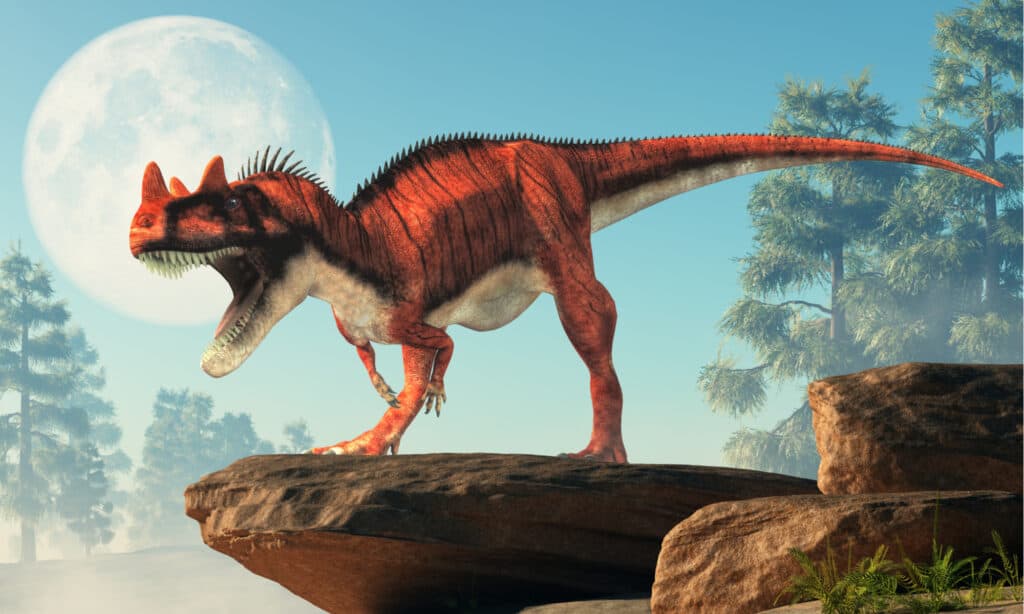
Horns are usually a defensive tool, so horns like the Ceratosaurus dinosaur has as a predator are rare.
©Daniel Eskridge/Shutterstock.com
Ceratosaurus is a large theropod dinosaur that lived in the Late Jurrasic period 153 to 148 million years ago. This dinosaur lived in North America, Europe, and parts of Africa. This dinosaur’s most unique trait is the horn on its snout, and it also has horns on its eyes. Horns on carnivore dinosaurs are rare, as they are more common on ceratopsian dinosaurs. The Carnotaurus is another type of carnivorous horned dino, but this species lacks the horn on its nose.
The Ceratosaurus horn could have been used to help it break out of its egg as a baby, or could have been used by males to spar. The large size of this species made it one of the largest, and most dangerous predators of its time, capable of growing to around 25 feet (7.62 meters) in length. Bony armor also ran down the Ceratosaurus’s back which helped protect it in fights.
2. Styracosaurus
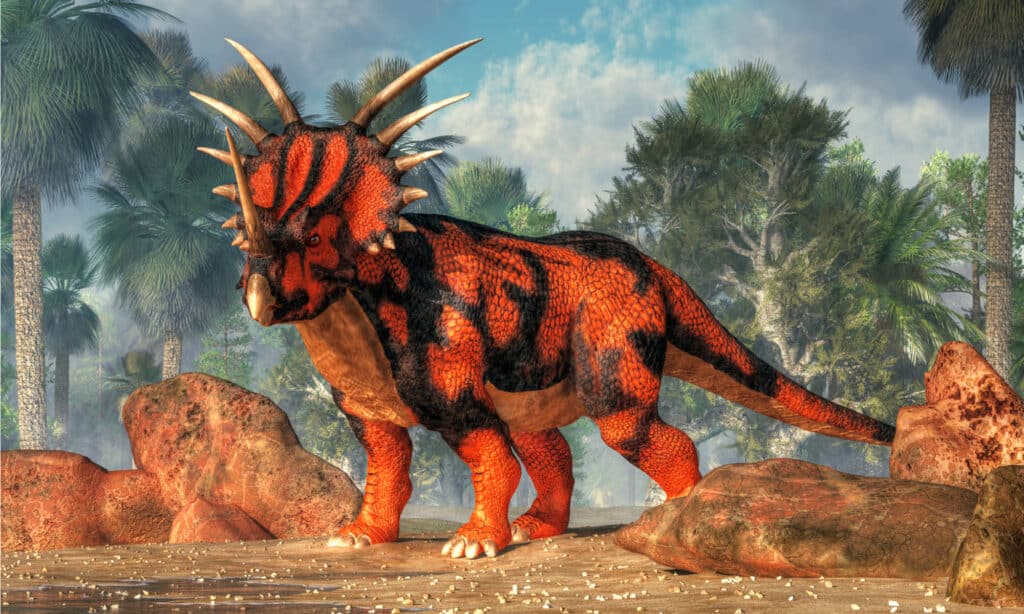
The Styracosaurus has six large horns in total.
©Daniel Eskridge/Shutterstock.com
The Styracosaurus is a dinosaur with many horns atop its head, and also one on its nose like a rhinoceros. This dinosaur lived during the Cretaceous period around 83.5 million years ago. Styracosaurus is one of the more common fossils in North America and has been uncovered in places such as Canada, Arizona, and Utah. This species is believed to have traveled in groups since fossil specimens have been discovered in large numbers together.
Standing at a height of around 5.9 feet (1.7 meters), the Styracosaurus reaches a length of around 18 feet (5.4 meters). Only weighing around 6,000 lbs (2,721.54 kg), the large groups they traveled in increased their survival rate. Their small size makes them easier for predators to pick off when alone. A large frill was located on top of this dinosaur’s head, as well as long horns protruding out of their skull. A horn is also located on their nose, all of which are useful in defending themselves from predators.
3. Aquilops
The Aquiops americanus is a small dinosaur around the size of a cat. This species lived 109 million years ago in North America, and it shows how different Ceratopsian dinosaurs could be. This dinosaur had a curved beak with a small horn on the tip of it. The Aquilops is only estimated to have grown to around 2 feet (0.6 meters) and weighed a very light 3 lbs (1.3 kgs).
Compared to other ceratopsian dinosaurs the Aquiolps was one of the smallest, and also lacked the very large horns and frill. Scientists believed this species survived off a diet of fruit and insects. The fossil of this dinosaur was first discovered in 1997 and was only recently described in 2014.
4. Monoclonius
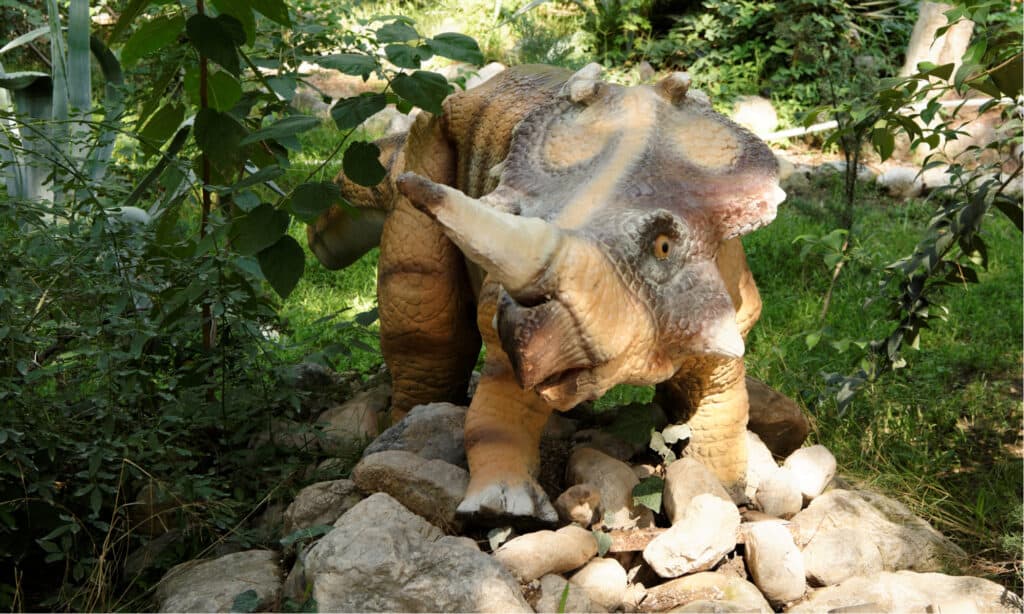
The name of the Monoclonius is in reference to the single horn on its face
©Aleks49/Shutterstock.com
The Monoclonius is a Ceratopaian dinosaur that lived in the Late Cretaceous period. It roamed the United States and other parts of North America. The Monoclonius only has one horn that shoots out of its face like a Rhino. There are only one species of Monolonius as of now, which is M. crassus. Around 15 different fossils of this dinosaur have been discovered, but it was first found in 1877.
The Monoclonius had a long horn that grew over a foot and came out of its nose. Based on fossil evidence it is estimated they grew to around 16.5 feet in length (5 meters), and weighed over 4,000 lbs (1814 kg).
5. Bagoceratops
Bagoceratops lived in Asia during the Cretaceous period. This dinosaur is a type of Ceratopsian but is much smaller than its relatives. Bagoceratops reached around 3.3 feet long (1 meter), and weighed around 50 lbs (22 kgs). While smaller in size than other Ceratopsians, they had much smaller horns and frills. The horn of the Bagoceratops is located on its nose, and only slightly protrudes from its face.
This dinosaur was a herbivore, and its beak made it easy to tear apart plants. They walked on all fours and resembled a mini version of the larger Ceratospains. The Bagoceratops was discovered in the 1970s in Mongolia, and most of its fossils are incomplete.
6. Ajkaceratops

The small Ajkaceratops is the first Ceratopsian species to be discovered in Europe.
©CC 3.0 / Nobu Tamura – License
Inhabiting Europe during the Late Cretaceous period, Ajkaceratops is a small Ceratopsian dinosaur. Not much is known about this species since only partial skull fragments have been discovered. Like a bird or turtle, this dinosaur has a small beak that it uses to break into the food it ate. Like other ceratopsian dinosaurs, they have traits like horns, a crest, and walk on all fours. This species is one of the smallest of Ceratopsians and only grows to around 3.3 feet (1 meter).
A small horn is located on the tip of the Ajkaceratops nose, like a miniature rhino horn. Their names mean horned face when translated from Greek, and this species lived in what is now Europe. The horn on their face was extremely small, and right above their beak.
7. Centrosaurus
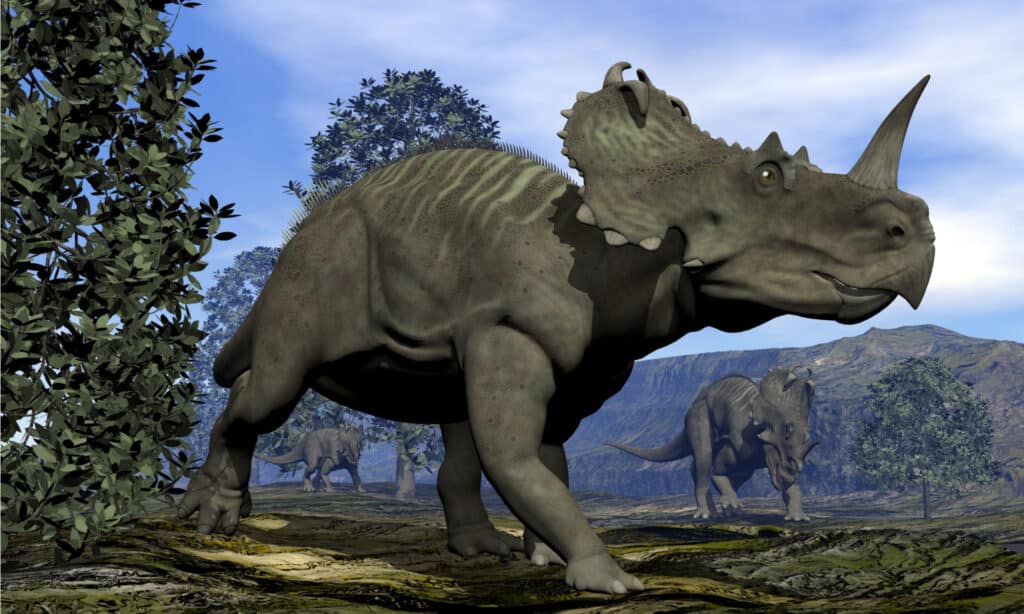
The Centrosaurus has many small points along its frill, as well as a large nasal horn.
©Elenarts/Shutterstock.com
The Centrosaurus lived around 83 million years ago during the Cretaceous period. This dinosaur lived in North America and was a type of Ceratopsian dinosaur. It is large, grew up to 20 feet in length (6 meters), and weighed as much as 6,000 lbs (2721 kgs).
What makes this dinosaur stand out from the rest is the large nasal horn on its face. Its horn was used to defend itself, and also impress mates. The horn on the Centrosuaurs grew to about 18 inches (45.7 cm), and was useful in defending against dangerous predators like the T-Rex or larger raptors. Around 46 fossils have been discovered of this species, and the first one was found in 1914.
The photo featured at the top of this post is © topimages/Shutterstock.com
Thank you for reading! Have some feedback for us? Contact the AZ Animals editorial team.



